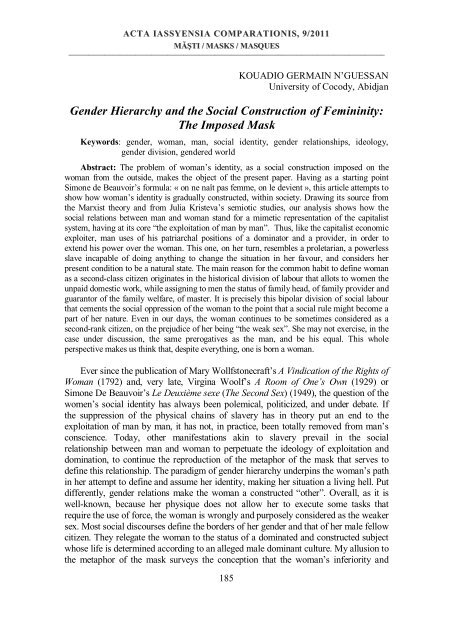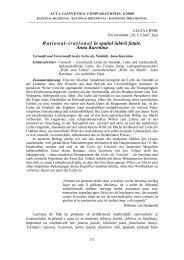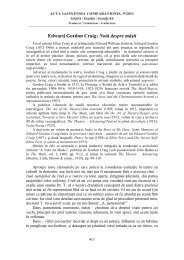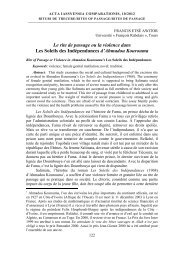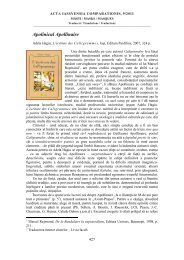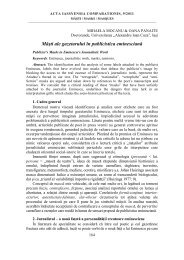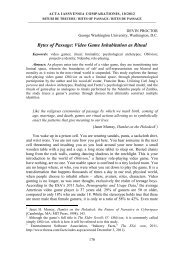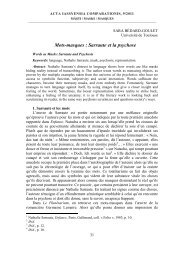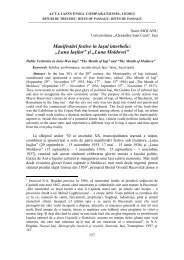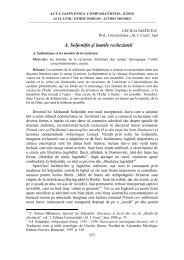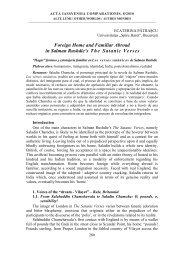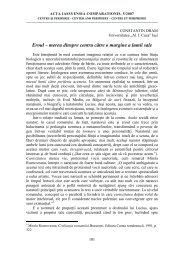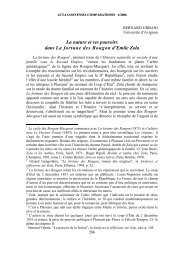Gender Hierarchy and the Social Construction of Femininity: The ...
Gender Hierarchy and the Social Construction of Femininity: The ...
Gender Hierarchy and the Social Construction of Femininity: The ...
Create successful ePaper yourself
Turn your PDF publications into a flip-book with our unique Google optimized e-Paper software.
ACTA IASSYENSIA COMPARATIONIS, 9/2011<br />
MĂŞTI / MASKS / MASQUES<br />
________________________________________________________________________________<br />
185<br />
KOUADIO GERMAIN N’GUESSAN<br />
University <strong>of</strong> Cocody, Abidjan<br />
<strong>Gender</strong> <strong>Hierarchy</strong> <strong>and</strong> <strong>the</strong> <strong>Social</strong> <strong>Construction</strong> <strong>of</strong> <strong>Femininity</strong>:<br />
<strong>The</strong> Imposed Mask<br />
Keywords: gender, woman, man, social identity, gender relationships, ideology,<br />
gender division, gendered world<br />
Abstract: <strong>The</strong> problem <strong>of</strong> woman’s identity, as a social construction imposed on <strong>the</strong><br />
woman from <strong>the</strong> outside, makes <strong>the</strong> object <strong>of</strong> <strong>the</strong> present paper. Having as a starting point<br />
Simone de Beauvoir’s formula: « on ne naît pas femme, on le devient », this article attempts to<br />
show how woman’s identity is gradually constructed, within society. Drawing its source from<br />
<strong>the</strong> Marxist <strong>the</strong>ory <strong>and</strong> from Julia Kristeva’s semiotic studies, our analysis shows how <strong>the</strong><br />
social relations between man <strong>and</strong> woman st<strong>and</strong> for a mimetic representation <strong>of</strong> <strong>the</strong> capitalist<br />
system, having at its core “<strong>the</strong> exploitation <strong>of</strong> man by man”. Thus, like <strong>the</strong> capitalist economic<br />
exploiter, man uses <strong>of</strong> his patriarchal positions <strong>of</strong> a dominator <strong>and</strong> a provider, in order to<br />
extend his power over <strong>the</strong> woman. This one, on her turn, resembles a proletarian, a powerless<br />
slave incapable <strong>of</strong> doing anything to change <strong>the</strong> situation in her favour, <strong>and</strong> considers her<br />
present condition to be a natural state. <strong>The</strong> main reason for <strong>the</strong> common habit to define woman<br />
as a second-class citizen originates in <strong>the</strong> historical division <strong>of</strong> labour that allots to women <strong>the</strong><br />
unpaid domestic work, while assigning to men <strong>the</strong> status <strong>of</strong> family head, <strong>of</strong> family provider <strong>and</strong><br />
guarantor <strong>of</strong> <strong>the</strong> family welfare, <strong>of</strong> master. It is precisely this bipolar division <strong>of</strong> social labour<br />
that cements <strong>the</strong> social oppression <strong>of</strong> <strong>the</strong> woman to <strong>the</strong> point that a social rule might become a<br />
part <strong>of</strong> her nature. Even in our days, <strong>the</strong> woman continues to be sometimes considered as a<br />
second-rank citizen, on <strong>the</strong> prejudice <strong>of</strong> her being “<strong>the</strong> weak sex”. She may not exercise, in <strong>the</strong><br />
case under discussion, <strong>the</strong> same prerogatives as <strong>the</strong> man, <strong>and</strong> be his equal. This whole<br />
perspective makes us think that, despite everything, one is born a woman.<br />
Ever since <strong>the</strong> publication <strong>of</strong> Mary Wollfstonecraft’s A Vindication <strong>of</strong> <strong>the</strong> Rights <strong>of</strong><br />
Woman (1792) <strong>and</strong>, very late, Virgina Woolf’s A Room <strong>of</strong> One’s Own (1929) or<br />
Simone De Beauvoir’s Le Deuxième sexe (<strong>The</strong> Second Sex) (1949), <strong>the</strong> question <strong>of</strong> <strong>the</strong><br />
women’s social identity has always been polemical, politicized, <strong>and</strong> under debate. If<br />
<strong>the</strong> suppression <strong>of</strong> <strong>the</strong> physical chains <strong>of</strong> slavery has in <strong>the</strong>ory put an end to <strong>the</strong><br />
exploitation <strong>of</strong> man by man, it has not, in practice, been totally removed from man’s<br />
conscience. Today, o<strong>the</strong>r manifestations akin to slavery prevail in <strong>the</strong> social<br />
relationship between man <strong>and</strong> woman to perpetuate <strong>the</strong> ideology <strong>of</strong> exploitation <strong>and</strong><br />
domination, to continue <strong>the</strong> reproduction <strong>of</strong> <strong>the</strong> metaphor <strong>of</strong> <strong>the</strong> mask that serves to<br />
define this relationship. <strong>The</strong> paradigm <strong>of</strong> gender hierarchy underpins <strong>the</strong> woman’s path<br />
in her attempt to define <strong>and</strong> assume her identity, making her situation a living hell. Put<br />
differently, gender relations make <strong>the</strong> woman a constructed “o<strong>the</strong>r”. Overall, as it is<br />
well-known, because her physique does not allow her to execute some tasks that<br />
require <strong>the</strong> use <strong>of</strong> force, <strong>the</strong> woman is wrongly <strong>and</strong> purposely considered as <strong>the</strong> weaker<br />
sex. Most social discourses define <strong>the</strong> borders <strong>of</strong> her gender <strong>and</strong> that <strong>of</strong> her male fellow<br />
citizen. <strong>The</strong>y relegate <strong>the</strong> woman to <strong>the</strong> status <strong>of</strong> a dominated <strong>and</strong> constructed subject<br />
whose life is determined according to an alleged male dominant culture. My allusion to<br />
<strong>the</strong> metaphor <strong>of</strong> <strong>the</strong> mask surveys <strong>the</strong> conception that <strong>the</strong> woman’s inferiority <strong>and</strong>
ACTA IASSYENSIA COMPARATIONIS, 9/2011<br />
MĂŞTI / MASKS / MASQUES<br />
________________________________________________________________________________<br />
<strong>the</strong>refore her subjugation are culturally <strong>and</strong> historically constructed. <strong>The</strong> mask would<br />
<strong>the</strong>n refer to a state <strong>of</strong> being <strong>and</strong> <strong>of</strong> acting that <strong>the</strong> woman is made to adopt in order to<br />
integrate her socio-cultural environment as a true subject.<br />
If most feminist <strong>the</strong>orists advocate <strong>the</strong> equality between sexes, social reality<br />
demonstrates <strong>the</strong> contrary. <strong>Social</strong> gender relationships teach us that <strong>the</strong>re has never<br />
been <strong>and</strong> <strong>the</strong>re is no true equality between <strong>the</strong> sexes. In many cases, <strong>the</strong> woman is<br />
defined as man’s subaltern <strong>and</strong> as such she evolves under his shadow. At <strong>the</strong><br />
beginning <strong>of</strong> Le Deuxième sex II, Simone de Beauvoir writes:<br />
One is not but born a woman. No biological, economic fate defines <strong>the</strong> character that <strong>the</strong><br />
female being has in society: it is <strong>the</strong> whole civilization that elaborates this middle product<br />
between <strong>the</strong> male <strong>and</strong> <strong>the</strong> castrato one qualifies as female. Only <strong>the</strong> mediation <strong>of</strong> <strong>the</strong><br />
o<strong>the</strong>r can constitute an individual as an O<strong>the</strong>r. (13, my translation)<br />
This quotation indicates that at <strong>the</strong>ir birth, both <strong>the</strong> male <strong>and</strong> female characters<br />
are bestowed <strong>the</strong> same prerogatives. Nothing terms <strong>the</strong> new baby born as a male or a<br />
female. It is later that society constructs <strong>and</strong> differentiates <strong>the</strong>ir condition on <strong>the</strong><br />
ground <strong>of</strong> o<strong>the</strong>rness <strong>and</strong> according to a gender hierarchy. Following Beauvoir’s<br />
assertion, it can be argued that femininity is socially, culturally <strong>and</strong> ideologically<br />
constructed <strong>and</strong> imposed on <strong>the</strong> female being. It is <strong>the</strong> society in which <strong>the</strong> woman<br />
lives that constructs her female identity according to norms that sometimes function<br />
as a cultural heritage that <strong>the</strong> inhabitants pass on from generation to generation. <strong>The</strong><br />
woman is brought up <strong>and</strong> educated in a context that perpetuates this ideology <strong>and</strong><br />
develops a sort <strong>of</strong> self-censorship. A collective unconsciousness invades <strong>the</strong> whole<br />
society <strong>and</strong> castrates <strong>the</strong> woman by positing her as man’s dependent. This situation is<br />
<strong>the</strong> same in many societies <strong>of</strong> <strong>the</strong> world.<br />
Pierre Bourdieu (1998) points out that <strong>the</strong> sexual division between man <strong>and</strong><br />
woman seems to be something natural, normal, <strong>and</strong> even unavoidable. At first sight,<br />
this natural, normal <strong>and</strong> unavoidable character <strong>of</strong> <strong>the</strong> sexual division destroys <strong>the</strong><br />
whole Beauvoirian <strong>the</strong>ory. Bourdieu seems to voluntarily forget that human beings<br />
can actually act on nature <strong>and</strong> make its elements function as <strong>the</strong>y want. He also<br />
seems to argue that effectively <strong>the</strong> social roles <strong>the</strong> man <strong>and</strong> <strong>the</strong> woman are assigned<br />
are not subject to human manipulation, that human beings have nothing to do with<br />
this social division. Fortunately, his argumentation clarifies his point. In <strong>the</strong> home as<br />
well as in <strong>the</strong> social world, this division is permanent. <strong>The</strong> different areas in <strong>the</strong> home<br />
are sexually divided. <strong>The</strong> kitchen, for example, is regarded as <strong>the</strong> woman’s area<br />
while man’s place is <strong>the</strong> dining room. This first division, to Bourdieu, is one that is<br />
objected, that is to say determined in accordance with <strong>the</strong> objects used in each area.<br />
In <strong>the</strong> kitchen, <strong>the</strong> woman exercises her influence through cooking <strong>and</strong> <strong>the</strong> cooking<br />
materials she uses are intended for that purpose. Similarly, man manifests his<br />
influence over <strong>the</strong> dining room <strong>and</strong> its equipments. Most <strong>of</strong> <strong>the</strong> time, while <strong>the</strong><br />
woman is busy cooking in <strong>the</strong> kitchen, man, if he is at home, is in <strong>the</strong> dining/livin<br />
room watching TV, listening to <strong>the</strong> radio or playing music.<br />
Bourdieu identifies a second level in <strong>the</strong> sexual division. This level is located in<br />
<strong>the</strong> social world <strong>and</strong> is incorporated in <strong>the</strong> bodies <strong>of</strong> people, <strong>the</strong>ir habits, <strong>and</strong> gestures.<br />
It operates as systems <strong>of</strong> perception, thought, <strong>and</strong> action <strong>and</strong> is carried out through<br />
186
ACTA IASSYENSIA COMPARATIONIS, 9/2011<br />
MĂŞTI / MASKS / MASQUES<br />
________________________________________________________________________________<br />
arbitrary divisions <strong>of</strong> <strong>the</strong> social world. No objective reason can account for <strong>the</strong> place<br />
each <strong>of</strong> <strong>the</strong> sexes must have. Because <strong>of</strong> an ideological conception <strong>of</strong> <strong>the</strong> social<br />
division <strong>of</strong> <strong>the</strong> world, <strong>the</strong> woman is maintained in a perpetual subordination. <strong>The</strong><br />
social order <strong>of</strong> <strong>the</strong> world, <strong>the</strong>refore, operates as a huge symbolic machine that aims to<br />
legitimate male domination on which it is based. Work division, distribution <strong>of</strong> <strong>the</strong><br />
activities, places <strong>and</strong> instruments allotted to each <strong>of</strong> <strong>the</strong> two sexes, all testify to this<br />
symbolic machine <strong>and</strong> explain this alleged natural male domination.<br />
<strong>The</strong> social world constructs human body as a sexual reality <strong>and</strong> as a site <strong>of</strong><br />
principles <strong>of</strong> vision <strong>and</strong> <strong>of</strong> sexual division. This incorporated social program <strong>of</strong><br />
perception applies to all <strong>the</strong> societies. It is a situation generated by what we know as<br />
<strong>the</strong> socialization <strong>of</strong> <strong>the</strong> individual, a process through which sexual roles are taught<br />
<strong>and</strong> attributed to both man <strong>and</strong> <strong>the</strong> woman since <strong>the</strong>ir teen-age <strong>and</strong> which <strong>the</strong>y must<br />
progressively incorporate <strong>and</strong> develop as part <strong>of</strong> <strong>the</strong>ir socio-cultural heritage till <strong>the</strong>ir<br />
adulthood. Once grown up, man <strong>and</strong> woman act in accordance with <strong>the</strong> codes <strong>of</strong> <strong>the</strong><br />
society in which <strong>the</strong>y were raised <strong>and</strong> educated. <strong>The</strong>ir actions, behaviors <strong>and</strong> thought<br />
which confer <strong>the</strong>m a social identity greatly testify to this reality. <strong>Gender</strong> <strong>the</strong>n is a<br />
daily construction society imposes on <strong>the</strong> individual. <strong>The</strong> latter must conceptualize<br />
<strong>and</strong> develop it in order to fit his/her environment. Defining gender <strong>and</strong> how it is<br />
constructed, Judith Butler (1990) writes:<br />
<strong>Gender</strong> is an identity tenuously constituted in time, instituted in an exterior space through a<br />
stylized repetition <strong>of</strong> acts. <strong>The</strong> effort <strong>of</strong> gender is produced through <strong>the</strong> stylization <strong>of</strong> <strong>the</strong> body<br />
<strong>and</strong>, hence, must be understood as <strong>the</strong> mundane way in which bodily gestures, movements,<br />
<strong>and</strong> styles <strong>of</strong> various kinds constitute <strong>the</strong> illusion <strong>of</strong> an abiding gendered life. (191)<br />
<strong>Gender</strong> is not factual data. It is constructed, sustained <strong>and</strong> imposed as a way <strong>of</strong> life.<br />
It becomes “factual” when incorporated into <strong>the</strong> habits <strong>and</strong> cultures <strong>of</strong> people. Its<br />
construction is a constant search for a place to express an identity. As such, gender<br />
relations are relations <strong>of</strong> power <strong>and</strong> domination. Each gender seeks to gain more power<br />
in order to dominate <strong>the</strong> o<strong>the</strong>r, “opposite” one. <strong>Gender</strong> hierarchy, as we presume it<br />
here, is <strong>the</strong> expression <strong>of</strong> a male desire to dominate <strong>the</strong> woman <strong>and</strong> is illustrative <strong>of</strong> a<br />
group or individual ego: as a member <strong>of</strong> a group thought <strong>of</strong> as <strong>the</strong> “strong sex”, man is<br />
animated by a supremacist ideology. In most <strong>of</strong> his relations with <strong>the</strong> woman, man’s<br />
prime <strong>and</strong> essential objective is to demonstrate this ideology <strong>and</strong> to make it effective, to<br />
consolidate his influence in <strong>the</strong> important social decisions. Thus, anything <strong>the</strong> woman<br />
undertakes in terms <strong>of</strong> gender relations or as part <strong>of</strong> <strong>the</strong> social division <strong>of</strong> <strong>the</strong> world is<br />
not seen as convincing or opportune if not supported or sponsored by male opinion.<br />
<strong>Social</strong> relations are generally gender-oriented. In <strong>the</strong> system <strong>of</strong> opposition<br />
man/woman, <strong>the</strong> woman appears as an instrument <strong>of</strong> conquest. Her body <strong>and</strong> mind<br />
are subjected to conquest from man. Ania Loomba (2005) argues that “<strong>the</strong> female<br />
bodies [symbolize] <strong>the</strong> conquered l<strong>and</strong>.” (129) To impose his superiority, man must<br />
conquer <strong>and</strong> dominate <strong>the</strong> whole social system <strong>and</strong> structures where <strong>the</strong> woman lives.<br />
In this context, <strong>the</strong> social system <strong>and</strong> structures <strong>of</strong> thought, beliefs <strong>and</strong> actions act as<br />
agents <strong>of</strong> conquest for man. Once he succeeds in dominating <strong>the</strong>se agents, he<br />
automatically has <strong>the</strong> woman under his influence. <strong>The</strong> use <strong>of</strong> <strong>the</strong> female body as a<br />
l<strong>and</strong> to conquer varies in accordance with <strong>the</strong> exigencies <strong>of</strong> history.<br />
187
ACTA IASSYENSIA COMPARATIONIS, 9/2011<br />
MĂŞTI / MASKS / MASQUES<br />
________________________________________________________________________________<br />
<strong>The</strong> specific male conception <strong>of</strong> <strong>the</strong> woman depends on <strong>the</strong> reality <strong>of</strong> a given<br />
epoch. Taking up Engels’s perspective about <strong>the</strong> woman’s condition in history,<br />
Simone de Beauvoir underlines that during <strong>the</strong> Stone Age, when <strong>the</strong> l<strong>and</strong> was a<br />
common property <strong>and</strong> strength was required for farm work, <strong>the</strong> woman was confined<br />
to <strong>the</strong> housework. Later, during <strong>the</strong> industrial age or <strong>the</strong> age <strong>of</strong> mechanization, with<br />
<strong>the</strong> advent <strong>of</strong> private ownership, man used o<strong>the</strong>r people he made into slaves to<br />
cultivate. He thus used <strong>the</strong> woman as a worker. This was in Beauvoir’s terms, <strong>the</strong><br />
world historical defeat <strong>of</strong> <strong>the</strong> woman (Le Deuxième sexe II, 97-98). <strong>The</strong> periodical<br />
<strong>and</strong> historical change in <strong>the</strong> woman’s social condition from <strong>the</strong> private sphere to <strong>the</strong><br />
public one did not imply her sexual or gender equality.<br />
Indeed, patriarchal ideologies are reluctant to accept <strong>the</strong> woman as man’s equal.<br />
Gayle Rubin in Rayna R. Reiter (1975) notes that <strong>the</strong> woman’s oppression through<br />
patriarchy exemplifies <strong>the</strong> capitalist system that Marx <strong>and</strong> his followers discussed at<br />
length in <strong>the</strong>ir works. In reading through Marxist <strong>the</strong>ories, Rubin articulates that <strong>the</strong><br />
woman’s “oppression in societies […] can by no stretch <strong>of</strong> <strong>the</strong> imagination be<br />
described as capitalist.” (163) Like in a capitalist system where <strong>the</strong> dominant<br />
character, <strong>the</strong> possessor <strong>of</strong> <strong>the</strong> means <strong>of</strong> production, <strong>the</strong> employer, exploits <strong>and</strong><br />
oppresses <strong>the</strong> dominated character, <strong>the</strong> worker, <strong>the</strong> woman under patriarchy wears<br />
<strong>the</strong> condition <strong>of</strong> <strong>the</strong> proletarian or dominated character. One essential example <strong>of</strong> this<br />
exploitation <strong>of</strong> <strong>the</strong> woman lies in <strong>the</strong> system sex/gender where <strong>the</strong> mode <strong>of</strong><br />
reproduction determines <strong>the</strong> relationship between <strong>the</strong> oppressor <strong>and</strong> <strong>the</strong> oppressed.<br />
Gayle Rubin fur<strong>the</strong>r states that “capitalism is a set <strong>of</strong> social relations […] in which<br />
production takes <strong>the</strong> form <strong>of</strong> turning money, things, <strong>and</strong> people into capital. And <strong>the</strong><br />
capital is a quantity <strong>of</strong> good or money which, when exchanged for labor, reproduces<br />
<strong>and</strong> augments itself by extracting unpaid labor, or surplus value from labor <strong>and</strong> into<br />
itself.” (161) In a similar way, <strong>the</strong> sex/gender system is a set <strong>of</strong> social relations in<br />
which, by <strong>the</strong> act <strong>of</strong> procreation, woman is turned into capital <strong>and</strong> <strong>the</strong> children she<br />
procreates are <strong>the</strong> goods. But <strong>the</strong> sex/gender system involves more than <strong>the</strong> relations <strong>of</strong><br />
procreation. It defines a social descending male/female gender organization. As <strong>the</strong><br />
oppressor, man is <strong>the</strong> “noble sex” whereas <strong>the</strong> woman, <strong>the</strong> oppressed, is a “perceived<br />
being”, that is to say her condition is defined from a patriarchal worldview. She must<br />
act according to what male dominant culture thinks she is or wants her to be. In one<br />
word, she is condemned to see herself through man’s eyes. This disposition between<br />
male nobility <strong>and</strong> female subjectivation consistently feeds <strong>the</strong> social relations. <strong>The</strong><br />
woman must interiorize this double bind to be a true woman: if she acts like a man, she<br />
loses her natural attributes <strong>of</strong> femininity, confirming thus man’s “natural” position <strong>of</strong><br />
power. Conversely, if she acts like a woman, she becomes incapable <strong>and</strong> unfit for her<br />
social environment. This ambivalence creates in <strong>the</strong> woman an unconscious which<br />
leads her to self-depreciation.<br />
<strong>The</strong> point I try to raise here is that <strong>the</strong> woman, in order to integrate her social<br />
world, unwillingly or helplessly submits to <strong>the</strong> patriarchal norms <strong>and</strong> consequently<br />
partakes in her own victimization. What is specific with a dominant class is its desire<br />
to impose its particular st<strong>and</strong>ards <strong>of</strong> being as universal. In many societies, <strong>the</strong> child’s<br />
education is generally gender-oriented. Whe<strong>the</strong>r <strong>the</strong> child is a boy or a girl, he/she<br />
receives a different or sexed education. In such circumstances, each gender<br />
188
ACTA IASSYENSIA COMPARATIONIS, 9/2011<br />
MĂŞTI / MASKS / MASQUES<br />
________________________________________________________________________________<br />
internalizes <strong>the</strong> social position imposed upon it by <strong>the</strong> outside world. For instance,<br />
while <strong>the</strong> girl is forbidden to take part to rough games because her physique is not fit<br />
for such games, <strong>the</strong> boy receives no restriction. <strong>The</strong> girl is <strong>of</strong>fered toys such as dolls<br />
or utensils, <strong>and</strong> during playtime she takes <strong>the</strong> dolls for her children <strong>and</strong> learns how to<br />
cook with <strong>the</strong> utensils. Admittedly, <strong>the</strong>se toys prepare <strong>the</strong> girl to her future status <strong>of</strong> a<br />
mo<strong>the</strong>r <strong>and</strong> her subsequent confinement in <strong>the</strong> private sphere <strong>of</strong> <strong>the</strong> home. <strong>The</strong> young<br />
girl grows up internalizing <strong>the</strong> female attributes <strong>and</strong> reactions she is early taught<br />
through <strong>the</strong> use <strong>of</strong> play things.<br />
Ano<strong>the</strong>r good example <strong>of</strong> <strong>the</strong> woman’s assimilation to a weak sex <strong>and</strong> <strong>the</strong>reby<br />
her continuous subjugation through patriarchal ideologies occurs in <strong>the</strong> public sphere.<br />
Experience demonstrates that <strong>the</strong> social world is more dem<strong>and</strong>ing <strong>and</strong> more<br />
restrictive to <strong>the</strong> female being than it is to <strong>the</strong> male one. While <strong>the</strong> female subject is<br />
asked to cross her legs when seated <strong>the</strong> male one can freely adopt any kind <strong>of</strong><br />
position. All <strong>the</strong> same, during public debates such as TV or radio broadcasts with<br />
male guests, <strong>the</strong> woman is most <strong>of</strong>ten ignored or deprived <strong>of</strong> language or even<br />
stopped during her times <strong>of</strong> speech. Sometimes, she is told that it is not her turn to<br />
take <strong>the</strong> floor or if <strong>the</strong> organizer dares to give her <strong>the</strong> floor, she is intermittently<br />
stopped. <strong>The</strong> woman must <strong>of</strong>ten protest to be given <strong>the</strong> floor or to signal her presence<br />
on <strong>the</strong> set. This way <strong>of</strong> trying to pass her ideas may create a climate <strong>of</strong> cacophony<br />
<strong>and</strong> turn <strong>the</strong> debate into some kind <strong>of</strong> dialogue <strong>of</strong> <strong>the</strong> deaf.<br />
<strong>The</strong> same system <strong>of</strong> misogyny occurs at <strong>the</strong> pr<strong>of</strong>essional level. Working places<br />
are <strong>of</strong>ten sexually segregated. Though <strong>the</strong>re are rare cases where <strong>the</strong> woman has <strong>the</strong><br />
same salary as her male colleague or earns more than him, she is generally<br />
discriminated against. Some historical <strong>and</strong> subjective reasons can explain this<br />
inequality. In fact, because <strong>the</strong> woman has historically been confined to <strong>the</strong> private<br />
sphere, her appearance in <strong>the</strong> public sphere is regarded by patriarchy as an intrusion,<br />
a challenge to or a contestation <strong>of</strong> its hegemony. Historically, too, <strong>the</strong> job <strong>the</strong> woman<br />
does in <strong>the</strong> private sphere is not paid. As such, her claim for a salary, even an equal<br />
or a higher wage in <strong>the</strong> public sphere seems to be beyond <strong>the</strong> underst<strong>and</strong>ing <strong>of</strong> many<br />
patriarchs. Many patriarchal advocates think that since in <strong>the</strong> home it is man who<br />
provides for <strong>the</strong> woman as his dependent, it is not necessary that <strong>the</strong> woman gets a<br />
(good) wage. This position puts into question <strong>the</strong> evolutionist <strong>and</strong> egalitarian<br />
ideologies that man <strong>and</strong> woman in society constitute <strong>the</strong> two faces <strong>of</strong> <strong>the</strong> same coin;<br />
if one <strong>of</strong> <strong>the</strong> faces is deteriorated, <strong>the</strong> coin loses its value. Unfortunately <strong>the</strong><br />
patriarchal structures encourage man to maintain <strong>the</strong> woman under his control <strong>and</strong> to<br />
reject, thus, <strong>the</strong> notion <strong>of</strong> gender equality.<br />
At <strong>the</strong> pr<strong>of</strong>essional level, <strong>the</strong>re always are expressions or terms that man astutely<br />
uses to extend his domination over <strong>the</strong> woman. Phrases such as “my little darling” or<br />
compliments such as “you are nicely dressed,” that <strong>the</strong> directors or managers,<br />
generally men, address to <strong>the</strong>ir secretaries, or again <strong>the</strong> small taps on <strong>the</strong>ir jaws as<br />
<strong>the</strong>y go by to express <strong>the</strong>ir kindness <strong>and</strong> sociability, are diversions from man to mark<br />
his territory, <strong>the</strong> work place, <strong>and</strong> express male domination. Sometimes, <strong>the</strong> woman’s<br />
oppression at work operates in <strong>the</strong> form <strong>of</strong> a sexual harassment. If she refuses<br />
advances from a male worker who happens to be her hierarchical responsible, she is<br />
<strong>of</strong>ten threatened with dismissal. A female job seeker may also experience similar<br />
189
ACTA IASSYENSIA COMPARATIONIS, 9/2011<br />
MĂŞTI / MASKS / MASQUES<br />
________________________________________________________________________________<br />
sexual harassment. She may have <strong>the</strong> qualifications but be declared unfit for <strong>the</strong> job<br />
if she does not comply with <strong>the</strong> immoral rules <strong>of</strong> having sex with <strong>the</strong> employer. To<br />
face <strong>the</strong> threats that make her helpless, <strong>the</strong> woman must adopt conformist attitudes to<br />
make her way through. Thus, in social life, <strong>the</strong> woman uses clothing techniques such<br />
as make-ups, figure-hugging dresses, tight-fitting trousers, <strong>and</strong> o<strong>the</strong>r ingredients <strong>of</strong><br />
beauty to make herself noticed. In so doing, she claims a presence in a world already<br />
marked out by male ideology.<br />
Significantly, <strong>the</strong>se clothing techniques confirm <strong>the</strong> woman’s status <strong>of</strong> a dominated<br />
<strong>and</strong> a constructed subject ins<strong>of</strong>ar as <strong>the</strong>y give <strong>the</strong> woman a sense <strong>of</strong> being. If <strong>the</strong>se<br />
techniques have important effects, it is underst<strong>and</strong>able that <strong>the</strong>y contribute to enforce <strong>the</strong><br />
effect <strong>of</strong> <strong>the</strong> social relations that put <strong>the</strong> woman in a position <strong>of</strong> a subject condemned to<br />
see him/her-self only through <strong>the</strong> eyes <strong>of</strong> <strong>the</strong> male categories. <strong>The</strong> woman exists as such<br />
because she acts in ways <strong>the</strong> male dominant society expects her to, by wearing clo<strong>the</strong>s<br />
that define her gender <strong>and</strong> by drawing <strong>the</strong> attention <strong>of</strong> those surrounding her. We can<br />
<strong>the</strong>refore assume that <strong>the</strong> woman’s gender identity is constructed <strong>and</strong> shaped by <strong>the</strong><br />
patriarchal norms <strong>of</strong> her society. If she does not conform to <strong>the</strong>se norms, she will evolve<br />
as an “invisible” human being: she will not, so to speak, exist. Existence, for <strong>the</strong> woman,<br />
<strong>the</strong>n, is synonymous with <strong>the</strong> ability to adapt to social requirements.<br />
<strong>The</strong> social institution <strong>of</strong> marriage in which man <strong>and</strong> woman are expected to<br />
mutually feed <strong>and</strong> respect each o<strong>the</strong>r is also an area <strong>of</strong> oppression for <strong>the</strong> woman.<br />
Simone de Beauvoir (1949) states that marriage, in fact, is always differently felt by<br />
<strong>the</strong> man <strong>and</strong> <strong>the</strong> woman. Both sexes are important in a marriage, but this importance<br />
does not always generate reciprocity between <strong>the</strong>m. <strong>The</strong> woman is never considered<br />
as man’s equal. <strong>Social</strong>ly, man is an autonomous <strong>and</strong> a complete individual. He is<br />
considered as a producer <strong>and</strong> his existence is determined by <strong>the</strong> work he does in his<br />
community. Contrary to him, <strong>the</strong> woman, in terms <strong>of</strong> marriage, embodies <strong>the</strong> slave in<br />
her community. Traditionally, she has functioned like an article. She was <strong>of</strong>fered by<br />
her parents, generally men, who determined <strong>the</strong> amount <strong>of</strong> <strong>the</strong> dowry to pay. <strong>The</strong><br />
marriage contracts were usually signed between <strong>the</strong> fa<strong>the</strong>r-in-law <strong>and</strong> <strong>the</strong> son-in-law<br />
to be or between <strong>the</strong> two in-laws respectively headed by male persons, but not<br />
directly between <strong>the</strong> man <strong>and</strong> <strong>the</strong> woman. This condition <strong>of</strong> <strong>the</strong> woman has not<br />
considerably changed with <strong>the</strong> evolution <strong>of</strong> <strong>the</strong> contractual form <strong>of</strong> marriage.<br />
Nowadays, marriage still preserves some <strong>of</strong> its traditional aspects. <strong>The</strong> woman in<br />
some societies can have her part <strong>of</strong> <strong>the</strong> dowry or heritage. However, <strong>the</strong>se goods still<br />
enslave her to her family.<br />
An important trait <strong>of</strong> <strong>the</strong> woman’s subjugation is that under marriage, she must<br />
adopt attitudes that illustrate her imposed identity. <strong>The</strong>se attitudes are more<br />
compelling to <strong>the</strong> young girl. Once married, <strong>the</strong> woman’s social identity changes<br />
against her will. She loses her maiden name for that <strong>of</strong> her husb<strong>and</strong>. She is, for<br />
example, called Mrs. Johnson, Mrs. Jones, Mrs. Fern<strong>and</strong>ez, Mrs. Bertr<strong>and</strong>, Mrs.<br />
Kouassi, etc. All <strong>the</strong> same, her husb<strong>and</strong> becomes a sort <strong>of</strong> imperialist. He is<br />
economically responsible for her, <strong>and</strong>, as such, he acts on her behalf within <strong>the</strong><br />
community. He chooses <strong>the</strong> home for <strong>the</strong> family, generally according to <strong>the</strong> place<br />
where he works. He is <strong>the</strong> conscience <strong>of</strong> <strong>the</strong> family, a half-god. <strong>The</strong> woman, in turn,<br />
is detached from her past, her usual environment. She is supposed to get integrated<br />
190
ACTA IASSYENSIA COMPARATIONIS, 9/2011<br />
MĂŞTI / MASKS / MASQUES<br />
________________________________________________________________________________<br />
into her husb<strong>and</strong>’s area, his social class <strong>and</strong> his family. She is “annexed” to his<br />
universe. In marriage, <strong>the</strong> woman’s life is reduced to repetition <strong>and</strong> routine. Usually,<br />
from early in <strong>the</strong> morning to late at night, if she does have a nanny to help her in her<br />
tasks, she must care for <strong>the</strong> welfare <strong>of</strong> <strong>the</strong> family alone. She must travel several times<br />
between home <strong>and</strong> school to send <strong>the</strong> younger children to school or take <strong>the</strong>m home,<br />
or she must go to <strong>the</strong> market to buy what <strong>the</strong> family needs. At home, she sweeps <strong>the</strong><br />
yard <strong>and</strong> <strong>the</strong> house, washes <strong>the</strong> dishes, <strong>and</strong> cooks for <strong>the</strong> family. She watches over<br />
<strong>the</strong> younger children <strong>and</strong> takes care <strong>of</strong> <strong>the</strong> old. On <strong>the</strong> smallest cry <strong>of</strong> a child, she is<br />
<strong>the</strong> first to rush up in order to see what is happening. This amount <strong>of</strong> work, usually<br />
unpaid, is done by <strong>the</strong> woman on <strong>the</strong> ground that it is her lot as a female being.<br />
<strong>The</strong> social world defines childbearing as one <strong>of</strong> <strong>the</strong> woman’s essential functions.<br />
Ann Oakley (1974) well underlines this function:<br />
Biological purpose seems to require completion through conceiving, being <strong>and</strong> nurturing<br />
children… Her generative organs seem meaningless unless her womb has been filled, her<br />
breasts suckled… <strong>The</strong> woman’s creativity as a mo<strong>the</strong>r becomes a central matter that<br />
provides meaning <strong>and</strong> balance to her life. (187)<br />
Society constructs <strong>the</strong> woman as a reproductive machine. It is through<br />
childbearing that her female condition is defined. From a traditional worldview, <strong>the</strong><br />
child assures autonomy to <strong>the</strong> woman. If as a wife <strong>the</strong> woman is not a complete<br />
human being, she attains this status as a mo<strong>the</strong>r: <strong>the</strong> child helps her to realize herself<br />
sexually <strong>and</strong> socially. Childbearing <strong>the</strong>n plays a crucial role in <strong>the</strong> woman’s life.<br />
Whatever her social or economic condition, <strong>the</strong> woman is nothing if she is childless.<br />
Children are a great social insurance. In this regard, any woman who does not want<br />
to procreate or whose biological condition does not permit her to procreate is a social<br />
pariah. In some traditional African societies, such women are considered as men.<br />
<strong>The</strong>y can take part in sacred ceremonies forbidden to women. <strong>The</strong>y can also take<br />
decisions which logically fall to men mainly when <strong>the</strong>y live in families where <strong>the</strong>re is<br />
no elderly male. Besides, when a couple have no child it is <strong>the</strong> woman who is <strong>the</strong><br />
first to blame for this situation.<br />
African female intellectuals take an interest in <strong>the</strong> traditional <strong>and</strong> cultural<br />
conception regarding mo<strong>the</strong>rhood <strong>and</strong> its role in <strong>the</strong> woman’s life. Admittedly, an<br />
important part <strong>of</strong> <strong>the</strong>ir writing falls within <strong>the</strong> scope <strong>of</strong> a feminist attack on traditional<br />
<strong>and</strong> cultural ideologies that prevent <strong>the</strong> African woman from owing her female self <strong>and</strong><br />
force her to live as an outcast when she is childless. It is important to indicate that my<br />
concern is not to lay emphasis on procreation as <strong>the</strong> woman’s ideal or her selffulfillment<br />
but to show how this contributes to put pressure on her, <strong>of</strong>ten leading to<br />
hysteria <strong>and</strong> psychological trauma. Here, <strong>the</strong> woman feels childlessness as a plight. She<br />
becomes culturally alienated as she takes <strong>the</strong> cultural ideologies <strong>of</strong> her community<br />
about childbearing for social norms <strong>and</strong> tries to live according to <strong>the</strong>m. Eventually, she<br />
comes to despise herself <strong>and</strong> consider herself useless for her community.<br />
From a feminist perspective, African female intellectuals explore childbearing as a<br />
place <strong>of</strong> oppression for <strong>the</strong> woman, which adds to <strong>the</strong> assumption that <strong>the</strong> woman lives<br />
in a permanently oppressive world. In <strong>the</strong> field <strong>of</strong> literature, Flora Nwapa in Efuru<br />
(1966) or Buchi Emecheta in <strong>The</strong> Joys <strong>of</strong> Mo<strong>the</strong>rhood (1979) largely account for <strong>the</strong><br />
191
ACTA IASSYENSIA COMPARATIONIS, 9/2011<br />
MĂŞTI / MASKS / MASQUES<br />
________________________________________________________________________________<br />
importance <strong>of</strong> children in <strong>the</strong> African woman’s life. In Efuru, for instance, when <strong>the</strong><br />
eponymous heroine does not procreate long after her marriage, <strong>the</strong> whole community’s<br />
expectations turn into despair. To <strong>the</strong>m, it is inconceivable that a woman should remain<br />
childless; only children may make a marriage happy <strong>and</strong> fulfilled. <strong>The</strong> complaint <strong>of</strong> <strong>the</strong><br />
community illustrates <strong>the</strong> traditional <strong>and</strong> cultural conception that a woman must give<br />
birth to children <strong>and</strong> that a marriage must “be fruitful”. (137) Efuru underst<strong>and</strong>s this too<br />
well <strong>and</strong> she knows that only this act can provide her with a social identity, with a<br />
sense <strong>of</strong> living, <strong>of</strong> being, <strong>and</strong> <strong>of</strong> belonging. To this purpose, she consults a traditional<br />
priest who asks her to regularly perform sacrifices by <strong>the</strong> village lake, at sunset, to<br />
make <strong>the</strong> ancestors let her have a baby (25-26).<br />
Contrary to Efuru, Nnu Ego, <strong>the</strong> protagonist <strong>of</strong> Emecheta’s text, gives birth to<br />
several children. Her great fertility contrasts with Efuru’s sterility. By opposing <strong>the</strong>se<br />
biological states, Nwapa <strong>and</strong> Emecheta explore <strong>the</strong> two limits <strong>of</strong> <strong>the</strong> female condition:<br />
<strong>the</strong> woman can ei<strong>the</strong>r suffer from a childlessness leading to her social isolation or she<br />
can be productive, which makes her a social icon. Efuru <strong>and</strong> Nnu Ego respectively<br />
embody <strong>the</strong>se two categories <strong>of</strong> women. While Efuru symbolizes what it means for <strong>the</strong><br />
woman to be childless, Nnu Ego is described as a goddess <strong>of</strong> fecundity: “many people<br />
appealed to her to make <strong>the</strong>m fertile.” (224) However, Nnu Ego’s sufferance depicted<br />
at <strong>the</strong> end <strong>of</strong> <strong>the</strong> novel – her having been ab<strong>and</strong>oned by her children <strong>and</strong> her lonely<br />
agony – brings into question <strong>the</strong> idea that children constitute a social insurance for <strong>the</strong><br />
woman. Procreation does not necessarily lead to happiness for <strong>the</strong> woman, as<br />
patriarchal ideology seems to make <strong>the</strong> woman believe by forcing her to admit that her<br />
social <strong>and</strong> female condition depends on her capability <strong>of</strong> conceiving children. <strong>The</strong><br />
value bestowed on this biological act is a continuation to <strong>the</strong> woman’s oppression <strong>and</strong><br />
her social confinement. Nnu Ego embodies, thus, <strong>the</strong> woman’s plight <strong>of</strong> devoting her<br />
whole life to her children, while receiving nothing in turn.<br />
If one <strong>of</strong> <strong>the</strong> woman’s roles is procreation, <strong>the</strong> fruit <strong>of</strong> this role, on <strong>the</strong> o<strong>the</strong>r<br />
h<strong>and</strong>, does not belong to her. <strong>The</strong> children she conceives are, first <strong>and</strong> foremost, <strong>the</strong><br />
“property” <strong>of</strong> her husb<strong>and</strong>, according to <strong>the</strong> patriarchal family model. In this<br />
perspective, <strong>the</strong> woman does not own her sexuality, nor <strong>the</strong> products <strong>of</strong> her sexuality.<br />
Since <strong>the</strong> social world recognizes man as socially <strong>and</strong> economically responsible for<br />
her, it <strong>the</strong>n follows that what <strong>the</strong> woman produces, in capitalistic terms, belongs to<br />
him. He is <strong>the</strong> capitalist while <strong>the</strong> woman constitutes <strong>the</strong> labor force. He has property<br />
rights over <strong>the</strong> children, stronger than those <strong>of</strong> <strong>the</strong> mo<strong>the</strong>r. This situation is essential<br />
in traditional societies <strong>and</strong> in most societies which still have some traditional<br />
st<strong>and</strong>ards <strong>of</strong> living. Even in modern societies, where children enjoy <strong>the</strong>ir right to<br />
autonomy earlier, <strong>the</strong> woman does not exercise her rights over <strong>the</strong>m to <strong>the</strong> same<br />
degree as <strong>the</strong> man. Radical feminists strongly oppose this social injustice. This is<br />
why <strong>the</strong>y advocate <strong>the</strong> re-appropriation <strong>of</strong> <strong>the</strong> woman’s body <strong>and</strong> <strong>the</strong> products <strong>of</strong> her<br />
sexuality to her. To <strong>the</strong>m, heterosexuality <strong>and</strong> <strong>the</strong>refore procreation are forms <strong>of</strong><br />
oppression for <strong>the</strong> woman as <strong>the</strong>y permit man to control woman’s body. <strong>The</strong>y<br />
contribute to <strong>the</strong> construction <strong>of</strong> <strong>the</strong> woman as a dominated subject ra<strong>the</strong>r than as an<br />
independent subject that can own its self. We underst<strong>and</strong> that for radical feminists,<br />
<strong>the</strong> social construction <strong>of</strong> gender operates like a system in which <strong>the</strong> woman, like <strong>the</strong><br />
proletarian, is a victim. She cannot realize herself sexually. <strong>The</strong>re is no need insisting<br />
192
ACTA IASSYENSIA COMPARATIONIS, 9/2011<br />
MĂŞTI / MASKS / MASQUES<br />
________________________________________________________________________________<br />
on <strong>the</strong> whole <strong>the</strong>ory <strong>of</strong> radical feminism. <strong>The</strong> one thing worth underlining is that <strong>the</strong><br />
position <strong>of</strong> radical feminists is justified by <strong>the</strong>ir postulation that heterosexuality<br />
reduces <strong>the</strong> woman to sexual dependence <strong>and</strong> enslavement.<br />
Julia Kristeva deals with <strong>the</strong> construction <strong>of</strong> <strong>the</strong> woman’s social identity through<br />
what she terms “femininity as marginality”. <strong>The</strong> woman’s identity is generally defined<br />
from <strong>the</strong> patriarchal point <strong>of</strong> view which is <strong>of</strong>ten motivated by male class interests.<br />
<strong>The</strong>refore, since patriarchy is <strong>the</strong> code that defines <strong>and</strong> also oppresses <strong>the</strong> woman, <strong>the</strong><br />
woman cannot be; she only exists negatively. She is, according to Kristeva, “that which<br />
cannot be represented, that which is not spoken, that which remains outside naming<br />
<strong>and</strong> ideologies.” (in Moi, 1985, 163) This definition clearly indicates <strong>the</strong> marginality <strong>of</strong><br />
<strong>the</strong> woman. She is described as absence, negativity, lack <strong>of</strong> meaning, irrationality,<br />
chaos, darkness. She is nonbeing. Here, <strong>the</strong> notion <strong>of</strong> marginality has something to do<br />
with <strong>the</strong> repression <strong>of</strong> <strong>the</strong> woman in terms <strong>of</strong> her place in society. This raises <strong>the</strong><br />
question <strong>of</strong> positioning in so far as what one qualifies as marginal depends on <strong>the</strong><br />
position one occupies. Patriarchy sees <strong>the</strong> woman as marginal because it develops a<br />
class interest, a position, which requires <strong>the</strong> repression <strong>of</strong> <strong>the</strong> woman to avoid that she<br />
puts this class interest into question, if she is accepted as an equal human being. In so<br />
doing, it determines a place for <strong>the</strong> woman <strong>and</strong> a place for itself. Any attempt from <strong>the</strong><br />
woman to cross <strong>the</strong> borderline is considered as defiance that needs to be repressed. This<br />
imaginary inside/outside world constitutes an ideological battlefield <strong>of</strong> man <strong>and</strong><br />
woman, but, since <strong>the</strong> social stage is dominated by patriarchal rules, this battle seems to<br />
be lost by <strong>the</strong> woman in advance. Kristeva fur<strong>the</strong>r states that if patriarchy sees <strong>the</strong><br />
woman as marginal in <strong>the</strong> symbolic order, that is to say <strong>the</strong> order dominated by <strong>the</strong> law<br />
<strong>of</strong> <strong>the</strong> fa<strong>the</strong>r, <strong>the</strong>n it can construct her as <strong>the</strong> borderline <strong>of</strong> that order. In her quest for<br />
equality, <strong>the</strong> woman st<strong>and</strong>s at this borderline <strong>and</strong> wants to cross it to integrate man’s<br />
world on equal terms. This intention or desire creates, in some way, a chaotic situation.<br />
Kristeva <strong>the</strong>n concludes that from a phallocentric point <strong>of</strong> view, <strong>the</strong> woman represents<br />
<strong>the</strong> necessary frontier between man <strong>and</strong> chaos, but because <strong>the</strong> woman is seen as<br />
marginal, she seems to merge with <strong>the</strong> chaos <strong>of</strong> <strong>the</strong> outside (167).<br />
<strong>The</strong> woman’s repression by patriarchy also exemplifies Kristeva’s notion <strong>of</strong><br />
abjection she extensively articulates in Revolution in Poetic Language (1984) 1 . To<br />
her, abjection is that which is “immoral, sinister, scheming, <strong>and</strong> shady: a terror that<br />
dissembles, a hatred that smiles, a passion that uses <strong>the</strong> body for barter instead <strong>of</strong><br />
inflaming it, a debtor who sells you up, a friend who stabs you…” (4) Many writers<br />
take up her term to make it more accessible <strong>and</strong> underst<strong>and</strong>able. David Glover <strong>and</strong><br />
Cora Kaplan (2000) state that “abjection’s ordinary meaning denotes being thought<br />
inferior, ei<strong>the</strong>r by oneself or by o<strong>the</strong>rs, something unworthy or vile, or less than<br />
human, <strong>and</strong> something to be cast out.” (32) For Judith Butler (1990), <strong>the</strong> abject<br />
designates that which has been expelled from <strong>the</strong> body, discharged as excrement,<br />
literally rendered ‘O<strong>the</strong>r’. This appears as an expulsion <strong>of</strong> alien elements, but <strong>the</strong><br />
alien is effectively established through this expulsion. <strong>The</strong> constitution <strong>of</strong> <strong>the</strong> ‘notme’<br />
as <strong>the</strong> abject establishes <strong>the</strong> boundaries <strong>of</strong> <strong>the</strong> body which are also <strong>the</strong> first<br />
contours <strong>of</strong> <strong>the</strong> subject. (181)<br />
1<br />
This English version is from Margaret Walker.<br />
193
ACTA IASSYENSIA COMPARATIONIS, 9/2011<br />
MĂŞTI / MASKS / MASQUES<br />
________________________________________________________________________________<br />
<strong>The</strong>se definitions, though different, meet on <strong>the</strong> idea that abjection is a state <strong>of</strong><br />
being one is made to experience. In this state, <strong>the</strong> abject is thought <strong>of</strong> as uncanny <strong>and</strong><br />
disgusting. He/she inspires something ignominious that repels. <strong>The</strong> social relations<br />
between man <strong>and</strong> woman exactly reproduce <strong>the</strong> same situation. Patriarchy assumes<br />
that <strong>the</strong> female sex must be kept under domination because it is inferior, marginal. It<br />
consequently develops an ideology <strong>of</strong> repulsion <strong>and</strong> depreciation to maintain <strong>the</strong><br />
woman in what can be called a social <strong>and</strong> cultural castration.<br />
<strong>The</strong> woman’s discharge, to take up Butler’s term, represents an expulsion from <strong>the</strong><br />
social <strong>and</strong> cultural construction <strong>of</strong> gender identity. <strong>The</strong> woman is victim <strong>of</strong> a<br />
construction <strong>of</strong> a “not-me,” that is to say that which is not part <strong>of</strong> me as subject <strong>and</strong><br />
consequently must be expelled. This “not-me” – which repulses as an alien element,<br />
discharge, excrement – is produced by gender pride that prevents man from<br />
transcending his class ego to accept <strong>the</strong> woman as his equal. <strong>The</strong> concept <strong>of</strong> “not-me,”<br />
<strong>the</strong>n, sets <strong>the</strong> boundaries <strong>of</strong> gender identity construction. <strong>The</strong> woman’s aspiration to be<br />
recognized as an active ra<strong>the</strong>r than a passive social subject is constantly challenged <strong>and</strong><br />
frustrated through negation <strong>and</strong> privation. <strong>The</strong> fact that man refuses to acknowledge<br />
woman as a free <strong>and</strong> independent subject ascribes to a fundamentally existentialist<br />
context: to exist, in <strong>the</strong> male worldview, means to submit <strong>the</strong> o<strong>the</strong>r, <strong>the</strong> abject, to<br />
patriarchal rules. On <strong>the</strong> o<strong>the</strong>r h<strong>and</strong>, for <strong>the</strong> woman, to exist is to be able to act on her<br />
own behalf; but because male dominant culture is defined as social norm for gender<br />
identification, female identity represents a denial, a negation, <strong>and</strong> subjugation. <strong>The</strong><br />
woman functions as man’s subaltern, his o<strong>the</strong>r, in a sort <strong>of</strong> cultural cannibalism which<br />
she seeks to overcome. In <strong>the</strong>ir social interaction, man is <strong>the</strong> “cannibal” who leans on<br />
his historical position <strong>of</strong> <strong>the</strong> strong sex (that has been so rooted in <strong>the</strong> collective<br />
conscience <strong>of</strong> people that it is now taken for a cultural reality) to oppress <strong>the</strong> woman.<br />
At this level, <strong>the</strong> notion <strong>of</strong> castration as that which frustrates one’s desire to act on<br />
one’s free will plays an important role in <strong>the</strong> analysis <strong>of</strong> social relations. It imprisons<br />
<strong>the</strong> conscience <strong>and</strong> delays <strong>the</strong> legitimate aspiration for self-identification <strong>and</strong> selfassertion.<br />
And progressively, but surely, <strong>the</strong> victim becomes caught in a trap from<br />
which he/she cannot escape.<br />
If in his relationships with <strong>the</strong> woman, man’s ultimate goal is to keep <strong>the</strong> woman<br />
under his domination, it is also important to indicate that sometimes <strong>the</strong> woman herself<br />
contributes to her own castration by passively admitting patriarchal ideologies. In so<br />
doing, she justifies <strong>the</strong> social assumption that female identity is imposed on <strong>the</strong> woman<br />
from <strong>the</strong> outside. Through <strong>the</strong> woman’s passivity, gender identity gets <strong>the</strong> characteristics<br />
<strong>of</strong> an imposition. It is true that <strong>the</strong> social world helps much by “formatting” <strong>the</strong> woman<br />
to a passive attitude. But she has her “play” in her subordination, which may make<br />
people think that she is a masochist subject. On many occasions, <strong>the</strong> woman refuses to<br />
play a foreground role; she prefers to let this place to <strong>the</strong> man. In daily life, we<br />
constantly see scenes in which <strong>the</strong> woman is prompt to disclaim a responsibility<br />
pretending that it falls to man. She usually takes refuge in declarations such as “I am<br />
only a woman, what can I do?” “This is a man’s work or responsibility” or “I cannot<br />
decide in <strong>the</strong> absence <strong>of</strong> my husb<strong>and</strong>” when she must take a decision concerning her<br />
family or her collectivity. Such declarations encourage man to take pleasure in what<br />
Pierre Bourdieu (1998) calls libido domin<strong>and</strong>i (“<strong>the</strong> desire to dominate”).<br />
194
ACTA IASSYENSIA COMPARATIONIS, 9/2011<br />
MĂŞTI / MASKS / MASQUES<br />
________________________________________________________________________________<br />
Woman’s refusal to assume some responsibility or o<strong>the</strong>r comforts or gives<br />
confidence to man in his position <strong>of</strong> a dominant subject. From <strong>the</strong>n on, his libido<br />
domin<strong>and</strong>i increases while <strong>the</strong> woman sinks into domination: <strong>the</strong> more man desires to<br />
dominate, <strong>the</strong> more <strong>the</strong> woman’s condition <strong>of</strong> a dominated subject takes form. Buchi<br />
Emecheta’s text to which I referred earlier portrays this self-repression <strong>of</strong> <strong>the</strong> woman.<br />
Nnu Ego, <strong>the</strong> heroine, knows that, as a woman, <strong>the</strong> bride price paid for <strong>the</strong> marriage <strong>of</strong><br />
her daughter Taiwo does not belong to her, but to Nnaife, <strong>the</strong> fa<strong>the</strong>r. Since <strong>the</strong> latter is<br />
in prison, <strong>the</strong> price should be paid to her, as a parent. But according to <strong>the</strong> patriarchal<br />
conception <strong>of</strong> her community, she must not take <strong>the</strong> bridewealth because she is a<br />
woman. So, she makes sure <strong>the</strong> price is paid to Adim, her son, as <strong>the</strong> male<br />
representative <strong>of</strong> her husb<strong>and</strong> (220). Outst<strong>and</strong>ingly, Nnu Ego’s refusal to assume <strong>the</strong><br />
responsibility by taking <strong>the</strong> bride price testifies that in her community, <strong>and</strong> in most<br />
African communities, children belong first <strong>and</strong> foremost to <strong>the</strong> fa<strong>the</strong>r, <strong>the</strong> man.<br />
In addition to its desire not to let <strong>the</strong> woman enjoy <strong>the</strong> products <strong>of</strong> her sexuality,<br />
patriarchy maintains <strong>the</strong> woman in utter silence. Martha J. Cutter (1999) points out<br />
that “women’s silence is part <strong>and</strong> parcel <strong>of</strong> a system <strong>of</strong> patriarchal representation that<br />
labels <strong>the</strong>m as passive objects ra<strong>the</strong>r than active creators.” (14) In many<br />
communities, <strong>the</strong> woman is silenced at many levels: political, cultural, <strong>and</strong> economic.<br />
This idea <strong>of</strong> confinement sends to Julia Kristeva’s term <strong>of</strong> “metonymy <strong>of</strong> a want-tobe”<br />
she articulates in Revolution <strong>of</strong> Poetic Language. As already mentioned, man’s<br />
wish to maintain <strong>the</strong> woman in <strong>the</strong> status <strong>of</strong> a subaltern ascribes to <strong>the</strong> central<br />
question <strong>of</strong> positioning. Such positioning is always motivated by a desire that<br />
Kristeva finds as a recurring pattern in o<strong>the</strong>rness:<br />
Desire is thus <strong>the</strong> movement that leaps over <strong>the</strong> boundaries <strong>of</strong> <strong>the</strong> pleasure principle<br />
<strong>and</strong> invests an already signifying reality – “desire is <strong>the</strong> desire <strong>of</strong> <strong>the</strong> O<strong>the</strong>r” – which<br />
includes <strong>the</strong> subject as divided <strong>and</strong> always in movement. Because <strong>the</strong> subject is<br />
desiring, he is <strong>the</strong> subject <strong>of</strong> a practice, which itself can be carried out only to <strong>the</strong><br />
extent that its domain – <strong>the</strong> “real” – is impossible since it is beyond <strong>the</strong> “principle<br />
ironically called pleasure.” This desire, <strong>the</strong> principle <strong>of</strong> negativity, is essentially death<br />
wish <strong>and</strong>, only as such, is it <strong>the</strong> precondition <strong>of</strong> that practice, which can be considered,<br />
in turn, an effectuation <strong>of</strong> desire. (131)<br />
Because man desires to control <strong>the</strong> woman, he has to silence her or deprive her<br />
<strong>of</strong> language. Language, indeed, is very important for <strong>the</strong> subject. It can condemn or<br />
release him/her. To deprive one <strong>of</strong> language is to posit one as a dependent subject in<br />
terms <strong>of</strong> language utterance. In such a position, <strong>the</strong> subject has no control <strong>of</strong> his/her<br />
linguistic self, since all <strong>the</strong> semiotic system is controlled by <strong>the</strong> dominant subject<br />
who is in <strong>the</strong> control <strong>of</strong> <strong>the</strong> linguistic structures as well. In <strong>the</strong> social world, <strong>the</strong><br />
woman is spoken about but does not speak for herself. She has no voice or does not<br />
act as a speaking subject. Luce Irigaray qualifies this imposed discursive pattern as<br />
<strong>the</strong> woman’s subjectivation to phallocratic discourse. Thus, in Le Langage des<br />
déments (“<strong>The</strong> Language <strong>of</strong> Dementia”, 1973), a study <strong>of</strong> <strong>the</strong> patterns <strong>of</strong> linguistic<br />
disintegration in senile dementia, Irigaray states: “Spoken more than speaking,<br />
enunciated more than enunciating, <strong>the</strong> demented person is <strong>the</strong>refore no longer really<br />
an active subject <strong>of</strong> enunciation.… He is only a possible mouthpiece for previously<br />
195
ACTA IASSYENSIA COMPARATIONIS, 9/2011<br />
MĂŞTI / MASKS / MASQUES<br />
________________________________________________________________________________<br />
pronounced enunciations.” (in Moi, 127) In <strong>the</strong> social structures <strong>of</strong> language, <strong>the</strong><br />
woman evolves as a demented subject. Her passivity embodied in her declarations<br />
(that I mentioned here above), as her refusal to assume responsibility in her<br />
community are expressions <strong>of</strong> patriarchal language patterns. When <strong>the</strong> woman asserts<br />
face to a situation that she is only a woman, that such task or such responsibility falls<br />
to man, or that she cannot decide on her husb<strong>and</strong>’s behalf, she reproduces patriarchal<br />
forms <strong>of</strong> domination. Her own language is for her a place <strong>of</strong> self-condemnation<br />
ra<strong>the</strong>r than one <strong>of</strong> release.<br />
<strong>The</strong> question <strong>of</strong> <strong>the</strong> woman’s condition is one <strong>of</strong> <strong>the</strong> many issues facing human<br />
beings in <strong>the</strong> new world context. If globalization, with mass-production <strong>and</strong><br />
consumerism, tends to unify <strong>the</strong> world into a huge planetary village, it is expected<br />
that social relations would also be “globalized”. Traditional relations between man<br />
<strong>and</strong> woman that confined <strong>the</strong> woman to <strong>the</strong> position <strong>of</strong> a subaltern, a demented<br />
subject, must be revised. <strong>The</strong> cultural patterns that shaped traditional society must<br />
also be rearticulated to fit <strong>the</strong> new world context. Ignacio Ramonet (1997) notes that<br />
this cultural readjustment embodies anthropologic culture, that is to say <strong>the</strong> culture <strong>of</strong><br />
“<strong>the</strong> traditions rooted in <strong>the</strong> customs, that <strong>of</strong> villages, fairs, <strong>and</strong> feasts, <strong>of</strong> proverbs<br />
<strong>and</strong> superstitions, <strong>of</strong> peasant recipes, <strong>of</strong> gr<strong>and</strong>-mo<strong>the</strong>r’s medicine <strong>and</strong> <strong>of</strong> traditional<br />
knowhow. This culture […] still greatly defines mentalities; it is at <strong>the</strong> origin <strong>of</strong><br />
numerous antinomies <strong>and</strong> serious misunderst<strong>and</strong>ings.” (204-05, my translation) This<br />
statement underscores <strong>the</strong> premise that <strong>the</strong> new cultural world order reproduces<br />
aspects <strong>of</strong> <strong>the</strong> traditional cultural system. But it is Raymond Williams in John Storey<br />
(1991) who better exposes this cultural reproduction:<br />
<strong>The</strong> traditional culture <strong>of</strong> a society will always tend to correspond to its contemporary<br />
system <strong>of</strong> interests <strong>and</strong> values, for it is not an absolute body <strong>of</strong> work but a continual<br />
selection <strong>and</strong> interpretation. In <strong>the</strong>ory, <strong>and</strong> to a limited extent in practice, those<br />
institutions which are formally concerned with keeping <strong>the</strong> tradition alive (in particular<br />
<strong>the</strong> institutions <strong>of</strong> education <strong>and</strong> scholarship) are committed to <strong>the</strong> tradition as a whole,<br />
<strong>and</strong> not to some selection from it according to contemporary interests. <strong>The</strong> importance <strong>of</strong><br />
this commitment is very great, because we see again <strong>and</strong> again, in <strong>the</strong> workings <strong>of</strong> a<br />
selective tradition, reversals <strong>and</strong> re-discoveries, returns to work apparently ab<strong>and</strong>oned as<br />
dead, <strong>and</strong> clearly this is only possible if <strong>the</strong>re are institutions whose business it is to keep<br />
large areas <strong>of</strong> past cultures, if not alive, at least available. (55)<br />
Unfortunately, <strong>the</strong> reproduction <strong>of</strong> <strong>the</strong>se aspects <strong>of</strong> traditional culture in some<br />
cases has led to <strong>the</strong> historical division <strong>of</strong> work that debased <strong>the</strong> woman. Also, today,<br />
many countries are so confronted to development problems that <strong>the</strong>y unconsciously<br />
develop a tendency to put <strong>the</strong> issue <strong>of</strong> gender equality at <strong>the</strong> background. In this<br />
context, it seems, <strong>the</strong> woman’s social identity will not improve as expected.<br />
If <strong>the</strong> situation <strong>of</strong> <strong>the</strong> western woman has greatly improved throughout history<br />
mainly because <strong>of</strong> <strong>the</strong> improvement <strong>of</strong> human rights <strong>and</strong> <strong>the</strong> actions <strong>of</strong> numerous<br />
feminist movements, even though some pending barriers are still to lower, that <strong>of</strong> <strong>the</strong><br />
under-developed <strong>and</strong> developing countries is still critical. In most African societies,<br />
for instance, <strong>the</strong> traditional barriers that stratify societies in gender classes still exist<br />
despite <strong>the</strong>ir contact with <strong>the</strong> western civilization. <strong>The</strong> numerous debates on or<br />
declarations in favor <strong>of</strong> this issue repeated at length by <strong>the</strong> leaders <strong>of</strong> <strong>the</strong>se countries<br />
196
ACTA IASSYENSIA COMPARATIONIS, 9/2011<br />
MĂŞTI / MASKS / MASQUES<br />
________________________________________________________________________________<br />
are <strong>of</strong>ten ways to divert people’s attention. Aminata Traoré (2002) is right to ask if in<br />
<strong>the</strong> Africa to build, African women can st<strong>and</strong> high by <strong>the</strong>ir men <strong>and</strong> claim, at <strong>the</strong><br />
same time <strong>and</strong> like <strong>the</strong>m, a new local <strong>and</strong> world order (117). This question extends to<br />
<strong>the</strong> whole world context. In most countries, <strong>the</strong> woman continues to live under <strong>the</strong><br />
shadow <strong>of</strong> man. On <strong>the</strong> political scene, <strong>the</strong>re are very few women who play<br />
important leading roles, <strong>the</strong> great mass being confined to secondary roles, generally<br />
under <strong>the</strong> supervision <strong>of</strong> men. At <strong>the</strong>ir workplace, women most <strong>of</strong>ten hold positions<br />
that have previously been organized <strong>and</strong> occupied by men. As regards wage level,<br />
<strong>the</strong>re are great differences between man’s <strong>and</strong> woman’s incomes for <strong>the</strong> same job <strong>and</strong><br />
<strong>the</strong> same amount <strong>of</strong> work. In addition, <strong>the</strong> woman is refused access to some jobs<br />
because she is thought to have physical features unfit for <strong>the</strong>m. Sexually, if she<br />
decides not to sacrifice her erotic life, <strong>the</strong>n she falls again under man’s domination.<br />
Finally, despite its great promises to settle populations’ preoccupations at a planetary<br />
level, globalization has not yet succeeded in finding a solution to gender inequality.<br />
Sheila Rowbotham <strong>and</strong> Stephanie Linkogle (2001) are cogent enough to indicate,<br />
in <strong>the</strong> light <strong>of</strong> this failure, that women’s mobilization for livelihood <strong>and</strong> rights is a<br />
resistance against globalization. A study <strong>of</strong> <strong>the</strong> women’s movements for <strong>the</strong><br />
improvement <strong>of</strong> <strong>the</strong>ir condition, in different parts <strong>of</strong> <strong>the</strong> world, <strong>the</strong>ir book pictures<br />
women’s actions for emancipation: fight for environmental <strong>and</strong> reproductive rights,<br />
mobilization against poverty <strong>and</strong> racism, fight against <strong>the</strong> inequalities imposed by<br />
structural adjustment programs, <strong>and</strong> campaign for human rights. <strong>The</strong>se different actions<br />
represent a skeleton <strong>of</strong> what globalization in terms <strong>of</strong> commonality <strong>and</strong> reduction <strong>of</strong> <strong>the</strong><br />
disparities among populations fails to achieve. In fact, little consideration has been<br />
given to <strong>the</strong> question <strong>of</strong> whe<strong>the</strong>r <strong>the</strong> suppositions behind <strong>the</strong> <strong>the</strong>ories <strong>of</strong> development or<br />
population policies actually relate to <strong>the</strong> realities <strong>and</strong> experiences <strong>of</strong> <strong>the</strong> woman herself.<br />
<strong>The</strong> historical portrayal <strong>of</strong> <strong>the</strong> woman as a passive recipient whose place is in <strong>the</strong><br />
household continues to make its way. Economic development requires <strong>the</strong> woman’s<br />
reproductive roles to support <strong>the</strong> household unit. But at <strong>the</strong> same time, it denies her<br />
reproductive rights through fixed notions <strong>of</strong> family size, fertility, <strong>and</strong> population<br />
control. <strong>The</strong>re arises here a double role imposed on <strong>the</strong> woman: when she must<br />
procreate to sustain <strong>the</strong> family or <strong>the</strong> community, <strong>the</strong>n her reproductive role is<br />
acknowledged. She is encouraged to bear children. In contrast, when <strong>the</strong> community’s<br />
livelihood to which she greatly contributes is to be shared out, she is urged to help<br />
reduce <strong>the</strong> population size through <strong>the</strong> control <strong>of</strong> her fertility. In such circumstances,<br />
<strong>the</strong> woman appears as an article whose importance depends on <strong>the</strong> owner.<br />
While <strong>the</strong> various approaches to <strong>the</strong> woman’s roles in development are exposing<br />
<strong>the</strong> international development organizations’ adherence to sexist assumptions about<br />
gender roles, little attention is paid to <strong>the</strong> interactions <strong>of</strong> o<strong>the</strong>r policies. Many<br />
international conferences or colloquia are organized that focus on <strong>the</strong> different<br />
actions to undertake in order to reduce <strong>the</strong> disparities between genders, but most<br />
<strong>of</strong>ten, <strong>the</strong> organizers do not implement <strong>the</strong> decisions taken. Sometimes, this does not<br />
occur for lack <strong>of</strong> means, but because <strong>of</strong> <strong>the</strong> patriarchal ideologies that still lie heavy<br />
on <strong>the</strong> collective conscience <strong>of</strong> <strong>the</strong> decision-makers. And if it is <strong>the</strong> woman who must<br />
undertake <strong>the</strong> necessary steps for <strong>the</strong> implementation <strong>of</strong> <strong>the</strong>se decisions, she<br />
constantly faces obstacles or she is convinced that time is not appropriate for such<br />
197
ACTA IASSYENSIA COMPARATIONIS, 9/2011<br />
MĂŞTI / MASKS / MASQUES<br />
________________________________________________________________________________<br />
actions. Thus, from disappointment to disappointment, she ei<strong>the</strong>r gives up or directs<br />
her energy to o<strong>the</strong>r goals not exclusively related to women’s issues.<br />
<strong>The</strong> declaration <strong>of</strong> <strong>the</strong> United Nations Women’s Decade in 1976 was received<br />
with great enthusiasm ins<strong>of</strong>ar as it recognized <strong>the</strong> woman as an active participant in<br />
development through her productive <strong>and</strong> reproductive roles. This period saw <strong>the</strong> birth<br />
<strong>of</strong> many development policies such as <strong>the</strong> equity approach which located <strong>the</strong><br />
woman’s subordination in <strong>the</strong> family but also in her relations with man in <strong>the</strong><br />
marketplace. <strong>The</strong> woman’s independence <strong>the</strong>refore should be achieved through<br />
equity <strong>and</strong> her needs were positioned with <strong>the</strong>ir rights to earn a livelihood. As a<br />
matter <strong>of</strong> fact, <strong>the</strong> woman was to be drawn into <strong>the</strong> development process through<br />
access to employment <strong>and</strong> <strong>the</strong> marketplace. Ano<strong>the</strong>r important approach, <strong>the</strong> gender<br />
<strong>and</strong> development approach (GAD), also came to life following <strong>the</strong> criticism that <strong>the</strong><br />
previous development policies targeted <strong>the</strong> woman without actually questioning<br />
social relations. It noted that <strong>the</strong> roles that man <strong>and</strong> woman are assigned in society<br />
are socially constructed <strong>and</strong> not natural. It sustained that <strong>the</strong> reproductive activities<br />
have historically been taken for granted <strong>and</strong> <strong>the</strong> woman’s contributions to <strong>the</strong><br />
household economy has not been considered, hence her invisibility in <strong>the</strong> economy.<br />
Finally, for <strong>the</strong> GAD, <strong>the</strong> assumptions that man is <strong>the</strong> provider <strong>and</strong> <strong>the</strong> woman <strong>the</strong><br />
consumer <strong>and</strong> a dependent are socially constructed (Rowbotham <strong>and</strong> Linkogle, 99-<br />
100). All this adds to <strong>the</strong> idea that <strong>the</strong> woman still has a long way to go for her social<br />
integration as man’s equal.<br />
What is <strong>the</strong> woman in <strong>the</strong> end? An independent human being or man’s o<strong>the</strong>r?<br />
This is <strong>the</strong> problem that I have tried to elucidate all along this essay. Going from<br />
Simone de Beauvoir’s assumption that one is not born a woman, that it is society that<br />
transforms <strong>the</strong> social roles assigned to man <strong>and</strong> woman, I have attempted to<br />
demonstrate that gender identity is actually a social construction. My argumentation<br />
was based on <strong>the</strong> idea that <strong>the</strong> social relations between man <strong>and</strong> woman are a<br />
reproduction <strong>of</strong> <strong>the</strong> capitalist system, with man as <strong>the</strong> capitalist <strong>and</strong> <strong>the</strong> woman as <strong>the</strong><br />
labor force. Historically, <strong>the</strong> woman was confined to <strong>the</strong> private sphere <strong>of</strong> <strong>the</strong> family,<br />
her major roles being to take care <strong>of</strong> <strong>the</strong> household <strong>and</strong> to bear children. She was<br />
considered as man’s subaltern, a constructed subject, an abject: she was man’s o<strong>the</strong>r.<br />
<strong>The</strong> evolution <strong>of</strong> <strong>the</strong> mentalities <strong>and</strong> human rights has led to <strong>the</strong> expectation that <strong>the</strong><br />
woman’s traditional roles would change. Unfortunately, <strong>the</strong> same patriarchal<br />
ideologies that have defined <strong>and</strong> maintained her as a secondary subject continue to<br />
subjugate her. She is almost <strong>the</strong> same as formerly. Even though some notable actions<br />
are undertaken to improve her condition, <strong>the</strong> woman is still confined to her traditional<br />
social roles. <strong>The</strong> question now is to know if we should give up hope. At this level,<br />
Mary Wollstonecraft’s response to <strong>the</strong> educational <strong>and</strong> political <strong>the</strong>orists <strong>of</strong> <strong>the</strong><br />
eighteenth century who wanted to deny women an education is still topical: <strong>the</strong><br />
woman ought to have an education commensurate with her position in society. She is<br />
essential to her nation because she educates its children <strong>and</strong> because she can be a true<br />
“companion” to her husb<strong>and</strong>, ra<strong>the</strong>r than a mere wife. Instead <strong>of</strong> viewing <strong>the</strong> woman<br />
as an ornament to society or a property to be traded in marriage, she must be treated<br />
as a human being deserving <strong>the</strong> same fundamental rights as man. But this egalitarian<br />
<strong>and</strong> evolutionist vision <strong>of</strong> gender relations is far from becoming a reality. For, in a<br />
198
ACTA IASSYENSIA COMPARATIONIS, 9/2011<br />
MĂŞTI / MASKS / MASQUES<br />
________________________________________________________________________________<br />
world where patriarchal ideologies continue to act as social norms, femininity<br />
continues to be a socially constructed identity imposed on <strong>the</strong> female subject, a mask<br />
she is compelled to wear <strong>and</strong> that sticks to her like her own shadow.<br />
WORKS CITED:<br />
Beauvoir, Simone de, Le Deuxième sexe II [1949], Paris, Gallimard, 1976.<br />
Bourdieu, Pierre, La Domination masculine, Paris, Éditions du Seuil, 1998.<br />
Butler, Judith, <strong>Gender</strong> Trouble: Feminism <strong>and</strong> <strong>the</strong> Subversion <strong>of</strong> Identity, London <strong>and</strong> New<br />
York, Routledge, 1990<br />
Emecheta, Buchi, <strong>The</strong> Joy <strong>of</strong> Mo<strong>the</strong>rhood, New York, George Braziller, 1979.<br />
Collins, Patricia Hills, Black Feminist Thought: Knowledge, Consciousness, <strong>and</strong> <strong>the</strong><br />
Politics <strong>of</strong> Empowerment, New York, Routledge, 1991.<br />
Hooks, Bell, Black Looks. Race Representation, Boston, South End Press, 1992.<br />
Howard, June, Toward a ‘Marxist-Feminist Cultural Analysis’, in “<strong>The</strong> Minnesota review”,<br />
N° 20, Spring, 1983.<br />
Kaczmarek, Sylvie, Femmes et féminismes d’hier à aujourd’hui, Toulouse, Erès, 1993.<br />
Kristeva, Julia, Revolution in Poetic Language, trans. Margaret Walker, New York,<br />
Columbia University Press, 1984.<br />
Loomba, Ania, Colonialism/Postcolonialism, second edition, London <strong>and</strong> New York,<br />
Routledge, 2005.<br />
Mikell, Gwendolyn, ed., African Feminism: <strong>The</strong> Politics <strong>of</strong> Surviving in Sub-Saharan<br />
Africa, Philadelphia, University <strong>of</strong> Pennsylvania Press, 1997.<br />
Moil, Toril, Sexual Textual Politics: Feminist Literary <strong>The</strong>ory, London <strong>and</strong> New York,<br />
Routledge, 1985.<br />
Nwapa, Flora, Efuru, Great Britain, Heinemann, 1966.<br />
Oakley, Ann, Housewife, London, Penguin Books, 1974.<br />
Ramonet, Ignacio, Géopolitique du chaos, Paris, Gallimard, 1997.<br />
Rowbotham, Sheila, <strong>and</strong> Stephanie Linkogle, eds., Women Resist Globalization: Mobilizing<br />
for Livelihood <strong>and</strong> Rights, London/New York: Zed Press, 2001.<br />
Rubin, Gayle, “<strong>The</strong> Traffic in Women: Notes on <strong>the</strong> ‘Political Economy <strong>of</strong> Sex,’” in Toward an<br />
Anthropology <strong>of</strong> Women, ed. Rayna R. Reiter, New York, Monthly Review Press, 1975.<br />
Storey, John, ed. Cultural <strong>The</strong>ory <strong>and</strong> Popular Culture: A Reader, Second Edition,<br />
Engl<strong>and</strong>, Pearson Prentice Hall, 1998.<br />
Traoré, Aminata, Le Viol de l’imaginaire, Paris, Fayard/Actes Sud, 2002.<br />
199


